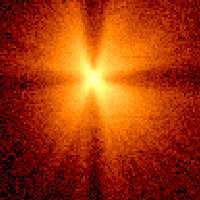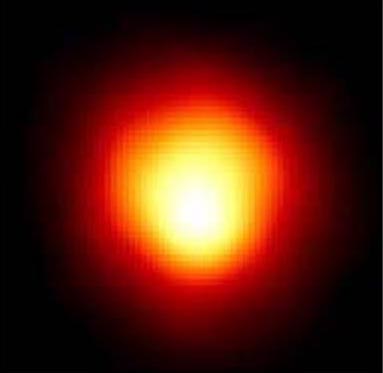|
|
More About Point Spread Functions
Astronomical observations are a funny thing. The image you get cannot be
any better than the instrument you are using, and
it cannot give you more information than the source itself contains.
Most lenses, including all telescopes, are not perfect optical systems. As
a result when light rays are passed through the telescope lens the
light undergoes a certain degree of degradation. This degradation of a
telescope is called its "point spread function" and it serves to limit,
in a sense, the information that can be gotten from a telescope. For
example, a telescope cannot resolve a point source, like a star. It is
too small, and the light that actually comes from a single point in
space gets blurred as it passes through the lens of the telescope.
The question is how can this
degradation be represented? Well suppose you have an exceedingly small
dot of light, a point, and project it through a lens. The image of this point
will not be the same as the original. The lens will introduce a small
amount of blur. The light from a distant star is just such a dot of light,
or "point source." You might think that such a source would appear as a
single point in an image, but because of a telescope's point spread
function, the image will actually appear to be spread out over many
pixels. Different telescopes have different point spread functions, and
some have less light distortion. But all telescopes have this property.

ROSAT image of a point source
|

ASCA image of a point source
|
Shown here are images of point sources that illustrate the point spread
function for the ASCA and ROSAT X-ray telescopes. If these were
undistorted representations of the star, the stellar image would be smaller
than a single pixel of the telescope. Because of the telescope's point spread
function, however, the stars appear to be many pixels across, and have a
distinct shape. For most stars, because they are so very far away, the
point spread function dominates the image, and no characteristics of the
star itself can be seen (its shape, for example).
It is possible to remove the distortion caused by a telescope's point
spread function (this distortion affects all observations, not just point
sources). However, when the point spread function is eliminated, the
telescope is still limited by its resolution. Resolution is a telescope's
ability to resolve very small objects. For all but the very largest stars,
and all but the very most advanced telescopes, the resolution limitations
of the telescope mean that the star's angular size is smaller than one
pixel of the detector. The one pixel that covers the part of the sky where
the star is located will capture all of the star's light (once the effects
of the point spread function are removed). The star will appear to be
square, because the one pixel is square! All stars of all sizes (but
smaller than the telescope's resolution) and the same luminosity will
appear to be the same size!
Compare the images above (point source images from different telescopes)
to the image of Betelgeuse below. Betelgeuse is a nearby red giant star.
Because of its large radius and closeness to Earth, it is not a point
source. It is several pixels across in the image from the Hubble Space
Telescope below.

|
